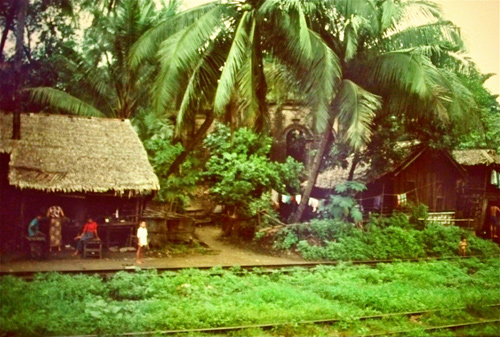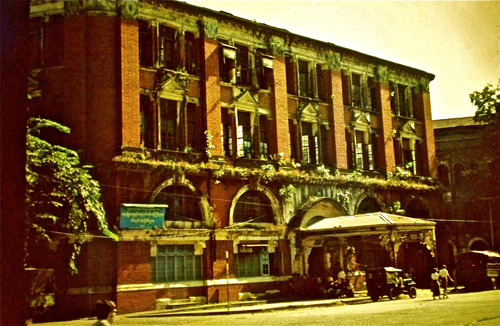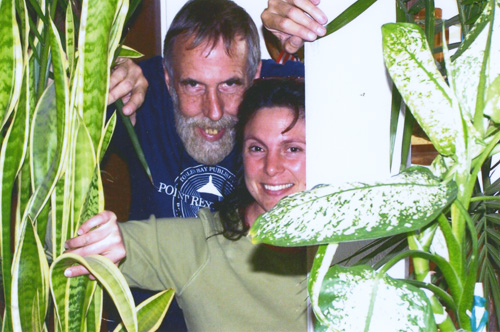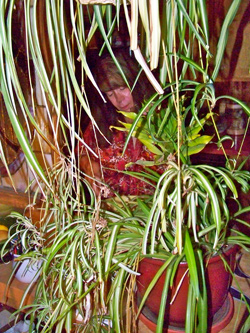When I was a lad in the 1940s, the fictional character who fascinated me was not Superman, Roy Rogers, or the Lone Ranger. It was Mowgli. Of course it’s easy to romanticize living naked with a pack of wolves, but one of Mowgli’s adventures in particular remains part of my life.
Mind you I’m not talking about the Mowgli of Walt Disney’s animated movie The Jungle Book. That trivialized portrayal of the youth would not come along for another 20 years. I’m talking about Mowgli, the hero of nine Rudyard Kipling short stories. My mother read me at least three of the stories from Kipling’s 1893 collection, The Jungle Book, and I was more intrigued by what Mowgli got to see than by what he actually did.
Kipling (1865-1936), a British short-story writer who won a Nobel Prize for Literature in 1907, made a name for himself in two disparate genres: 1) children’s stories; and 2) stories and poems about British imperialism in India. The Jungle Book, naturally, is set in an Indian jungle.
 Mowgli growing up with wolves. (Illustrations by Fritz Eichenberg)
Mowgli growing up with wolves. (Illustrations by Fritz Eichenberg)
Mowgli is the boy who grows up in the jungle with a pack of wolves after his parents lose him during a tiger attack. A mother wolf with cubs decides to raise the child as a man cub, and because he is hairless, she names him “Mowgli,” which apparently is wolfspeak for “Frog.”
Mowgli’s greatest accomplishment is to kill a malicious tiger, Shere Khan. With help from two wolves, he causes water buffalo at two ends of a ravine to stampede down it. Shere Khan gets caught in the middle and is trampled.
Monkeys in the abandoned city of Cold Lairs sit around its crumbling palace.
For me, the highpoint of the stories occurred when a pack of monkeys kidnapped Mowgli and took him to the Cold Lairs, an abandoned city complete with a palace half overgrown with jungle. Mowgli escaped when Kaa, the python, hypnotized the monkeys with a writhing “hunger dance,” but that wasn’t what intrigued me.
What I, as a young boy, found hardest to imagine was a jungle so aggressively overgrowing grand buildings from past cultures that the buildings ultimately disappear. When my mother assured me that large structures really can get lost in tropical forests, I began to fantasize about finding one.
A Burmese family’s home faces the railroad tracks while out in back tropical foliage has begun to swallow a deteriorating British-colonial building. (Seen from a train approaching Rangoon, 1986.)
It was only when I finally made it to such places as Guatemala, Thailand, and Burma in the 1980s that I saw for myself how readily jungle vines, bushes, and even trees can take root on abandoned edifices such as temples, palaces, and government buildings.
Vines and other foliage taking over an abandoned commercial building in downtown Rangoon create a romantic sadness. It may be exotic, but it’s hard not to feel sentimental when seeing former grandeur being consumed by opportunistic plants.
I’ve carried my fascination with intrusive jungle life with me for many years. The area around my desk in the old Point Reyes Light newsroom in the Creamery Building was filled with laurentii and dieffenbachia while pots of philodendrons and spider plants hung from the rafters.
As it happened, the California Newspaper Publishers Association (CNPA) in 2004 named The Light first in Public Service statewide for a series of stories about a Guatemalan immigrant who was attacked in Bolinas and nearly died. His personal tragedy was a catastrophe for his family. His wife was very ill, and he had been supporting her and the rest of his family, who were living in rural poverty in a remote area of Guatemala.
Light reporter Ana Carolina Monterroso and photographer Anika Zappa covered the story from Guatemala while Victoria Schlesinger was the key reporter in West Marin. Victoria represented the newspaper at the awards ceremony aboard the Queen Mary, and CNPA wanted a photo of Light staff to project on a screen while she received the Public Service plaque. The newsroom’s jungle was the perfect backdrop to symbolize the back country of Guatemala, so Victoria and I (above) posed amid the foliage. ________________________________________________________________
My love of the jungle is most evident these days inside Mitchell cabin. Here and there spider plants cascade down from the loft into the living room and dining room below.
Screened from the dining room by a floor-to-ceiling tower of spider-plants, Lynn prepares dinner in our kitchen.
___________________________________________________________
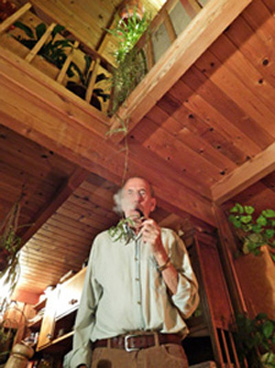 If you don’t look where you’re going in the dining room, it’s easy to find greenery in your face.
If you don’t look where you’re going in the dining room, it’s easy to find greenery in your face.
Lynn and I have pretty much learned to avoid becoming entangled, but guests are forever brushing spider plants out of their hair.
__________________________________________________________
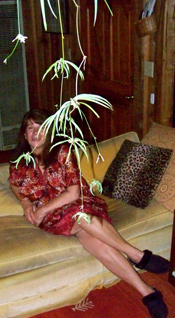 Having spider plants hanging into the living room from the floor above often results in our peering through a bit of jungle while carrying on a conversation.
Having spider plants hanging into the living room from the floor above often results in our peering through a bit of jungle while carrying on a conversation.
What’s more, it only takes a little jungle to make everything seem more exotic. I may have moved into the village, but deep inside me the romanticism of Mowgli in the Cold Lairs palace lives on.
___________________________________________________________


